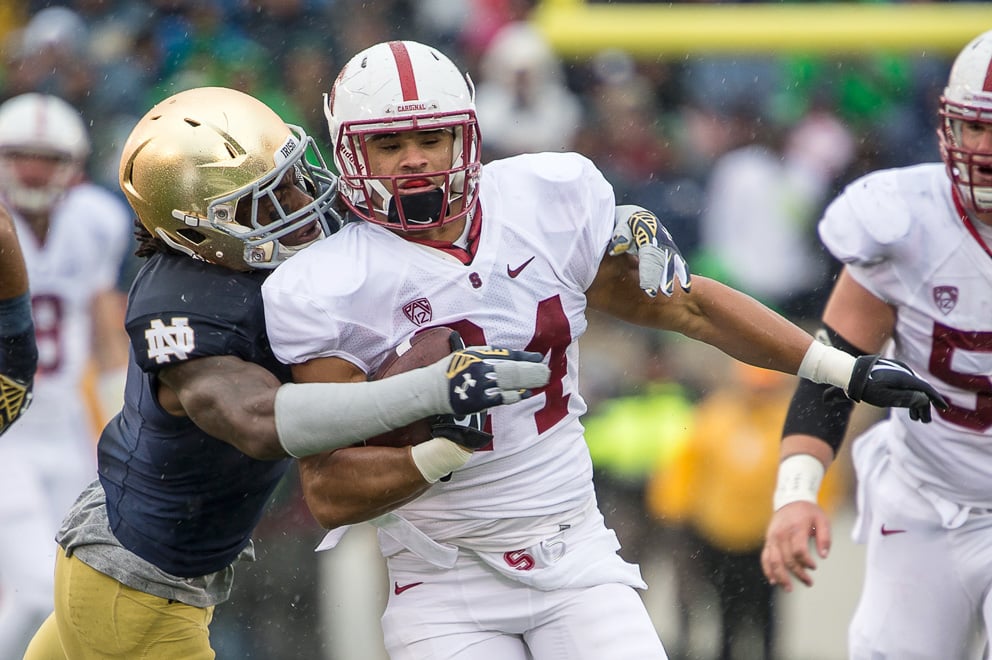In the heart of the Arizona desert, the Stanford football team decided to reenact its own version of “The Good, the Bad, and the Ugly” in a 26-10 defeat at the hands of the Arizona State Sun Devils.
It was a hallmark game for several reasons: The Sun Devils avenged last season’s beat-down in the conference championship game, Stanford suffered three regular season losses for the first time this decade and the Wild West of the Pac-12 is as unpredictable as ever.
Without further ado, let’s return to the scene of the crime and break down Stanford-ASU by the numbers:

25:03: Stanford’s total time of possession. In 2011, Andrew Luck’s senior year, Stanford ranked fifth in the nation in average time of possession at 33:46 per game. Fast forward back to Saturday, and the Cardinal offense struggled mightily to stay on the field. On the other side of the ball, the normally stout Stanford defense was worn down from having to contain the up-tempo Sun Devil attack for almost 35 minutes. There are a lot of factors that went into Stanford’s offensive ineptitude, but for starters, we can take a look at…
6-of-16: Stanford’s third-down conversion rate. This stat isn’t new territory for the Cardinal, which have struggled on third down throughout the season. In fact, Saturday wasn’t even Stanford’s worst performance on third-down conversions; the abysmal 3-for-12 mark against Washington is still the leader in the clubhouse. Typically, the Stanford offensive formula relies on a bludgeoning running game to set up third-and-short situations, but that just hasn’t panned out this season. Out of the 89 plays Stanford has run on third down this season, only 20 of them have come from within three yards of the first-down marker. That percentage of 22.5 is a far cry from the 38.5-percent mark from last season.
16: Arizona State’s margin of victory, the largest for the Sun Devils against a Pac-12 opponent all season. Even Colorado, with all of its offensive struggles, managed to put up 24 points on ASU and fall by 14 points. For Stanford, the 16-point loss marked the program’s worst defeat since losing to Oregon by 23 back in 2011; in fact, Saturday’s loss at Sun Devil Stadium was the first Stanford loss decided by more than one possession since that 2011 showdown with the Ducks.
7: The number of different ball-carriers with at least one rushing attempt for Stanford. Throughout the season, David Shaw has not shied away from the by-committee approach to the Stanford running game; if anything, the wealth has been spread even more. With freshman Christian McCaffrey now in the mix to get carries as well as fullback Patrick Skov emerging as the Cardinal’s goal-line back of choice, the number of mouths to feed in the Stanford backfield has grown over the course of the season. Against ASU, no Cardinal runner even reached 10 attempts, with Remound Wright leading the way at nine. In total, Stanford recorded 22 rushing attempts against the Sun Devils, the same number Tyler Gaffney had by himself last season in the Pac-12 Championship Game — for nearly 60 more yards.
4: The number of consecutive starts Kevin Hogan has lost against ranked opponents, including all three such games from this season. After starting his career 6-0 in 2012 with five wins against ranked opponents, Hogan developed a reputation as a big-game quarterback. That aura of invincibility only grew in 2013 as Hogan recorded another six wins against opponents before Michigan State finally ended the streak at 11. But since then, including that Rose Bowl, Hogan and Stanford have dropped their last four contests to ranked opponents.
72: The number of consecutive weeks Stanford was ranked in the top 25 of the AP poll before falling out this week. This streak, which dates back to the 2010 Orange Bowl campaign, marks the end of one of the most successful and unexpected runs in the modern college football era. Stanford now returns to the realm of the unranked.
Contact Vihan Lakshman at vihan ‘at’ stanford.edu.
